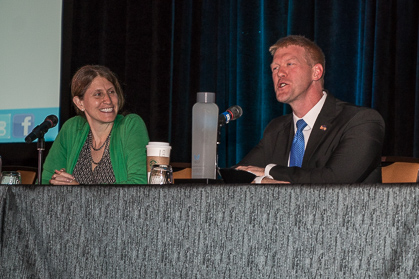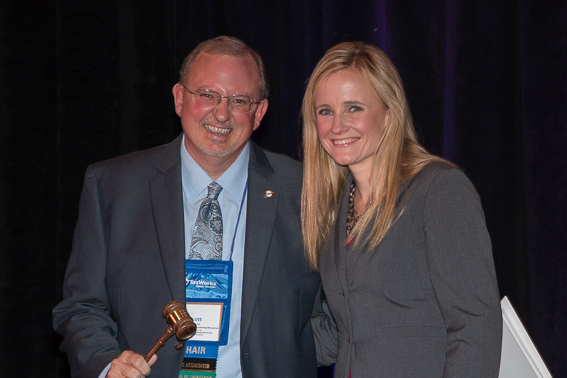 Conference takeaways:
Conference takeaways:
- Focus on customer satisfaction should be one of your top prioroties
- The flood of screening-related legislation continues to surge
- You should prepare now for screening changes in the EU
- Legalized marijuana is burning up business profits
In this report:
- Learn how to create the Disney magic in your company
- Two legislative bills could drastically reduce your financial liability
- Can you think like a lawyer?
- Plan now for a lawsuit later
- Staffing companies pose unusual challenges for CRAs
- How to grow your business and keep your customers
- Giant changes are in store for EU screening
- The real story of legalized marijuana
- Drug and alcohol testing – who’s in charge here?
Conference Summary
The NAPBS Annual Conference was held September 17-19 in Orlando, FL. Despite a few cancellations due to Hurricane Irma, the show set new attendance records: 817 members attended, along with exhibitors from 68 companies, making it the largest conference in the association’s history. In fact, at the show’s “Town Hall” meeting, the association reported that year-over-year membership is up 28% and annual conference participation was up 7%.
The theme of this year’s show was “Creating Magical Connections,” given the show’s proximity to Walt Disney World. The morning that the conference started, 48 golfers got a soggy jump on things by playing in the Sue Weaver Chipping in for a Cause Tournament at the Celebration Golf Club. Matt Lowers with Wholesale Screening Solutions even hit the Hole in One, picking up a check for $10,000.
Note: All speakers at the conference participated at the request of NAPBS and do not represent the official positions of their agencies or companies. Similarly, attorneys’ presentations were intended to provide general information on various regulatory and legal issues and not intended to serve as legal advice or counsel on any particular situation or circumstance.
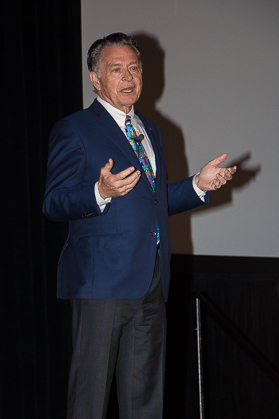 Keynote Address: Lessons in Leadership, Management and Customer Service. You Can Create Disney Magic, Too!
Keynote Address: Lessons in Leadership, Management and Customer Service. You Can Create Disney Magic, Too!
Executive takeaways:
- The most important parts of your job are hiring, training and serving as a role model
- You should never forget to “burn the free fuel” with your employees
- Customers and employees want the same basic things
Lee Cockerell, former Executive VP of Operations for the Walt Disney World Resort, kicked things off Monday morning with an inspirational session outlining his keys for success for any sized organization. Cockerell led a team of 40,000 Disney “cast members” and was responsible for the operations of 20 Disney hotels, four theme parks, two water parks, a shopping and entertainment village, and the ESPN sports and recreation complex.
Cockerell said he knew he couldn’t be an expert in all areas of the parks’ operations, so he made sure to:
- Be involved in the entire process (screening, interviews)
- Train employees thoroughly and clearly set expectations for them
- Serve as a good role model. As his wife told him: “Everyone is always watching and judging you.”
He said Disney strives to create an environment where everyone feels their ideas matter – but they can’t be put into action without review and discussion. Since a visitor may interact with up to 100 or more Disney employees every day, it’s imperative that the experience is consistent across the board.
Cockerell said that when it comes to employees, bosses often forget to “burn the free fuel” of appreciation, recognition and encouragement. He added that you need to get to know your employees well enough so you’ll be able to tell when they need help, since they probably won’t ask for it.
According to Cockerell, to be an effective boss, you need to master:
- Technical competency – staying on top of the technology changes in your business
- Task management – are you handling the tasks that are really important each day? Cockerell recommends using a paper planner and being disciplined about using it.
- Leadership skills – leadership is about being the kind of person who can help, make the tough decisions and have the tough conversations. Would your people like to work with you and trust you if you weren’t in the top part of the company?
Cockerell described a one-sentence survey Disney asked of 6,300 visitors: “What do you expect from Disney when you come here?” The top answers from the guests weren’t too surprising, but what caught Disney management’s attention was how they almost perfectly mirrored what the employees were seeking.
“Make me feel special”
“Treat me as an individual”
“Show respect to me and my family, no matter our background, race, sexual preference, etc.”
He underscored that last point with an unofficial, tongue-in-cheek slogan that also translates to any business: “Mickey Mouse likes all currency.”
Legislative Update
Executive takeaways:
- Just about every state is introducing legislation that affects the screening industry
- NAPBS’ top federal legislative priorities are bills that reduce liability
Francine Friedman with Akin Gump and Brent Smoyer of Smoyer Government Affairs underscored the sheer volume of legislation affecting screening by noting that only 2 states in the country did not have any pending laws or regulations. In total, 313 bills have been introduced since the beginning of the year.
The top 10 issues (in alphabetical order):
- Access to records
- Ban the Box
- Credit checks
- Employment screening
- Expungement
- Fingerprinting
- Privacy/public records
- Ridesharing
- Salary history
- Tenant screening
Friedman and Smoyer said that while NAPBS continues to monitor these issues and work to educate lawmakers on them, the association’s top federal priories center around legislation to reduce liability.
The first is the FCRA Liability Harmonization Act (H.R. 2359), which caps the amount of statutory damages allowed in class action lawsuits and eliminates the availability of punitive damages. This bill would cap class action damages at the lesser of $500,000 or 1% of the defendant’s net worth and make damages under FCRA more consistent with other consumer-protection laws. It would also allow individuals who experience actual harm to bring actions and be compensated. The benefit to the industry would be to make screeners less of a target for aggressive class action attorneys who seize on technical violations of FCRA.
The second bill is known as the Certainty in Enforcement Act (H.R. 1646). This bill amends equal opportunity requirements under the Civil Rights Act of 1964 to deem an employer’s, labor organization’s, employment agency’s, or joint labor management committee’s consideration or use of credit or criminal records or information, as mandated by federal, state, or local law, to be job related and consistent with business necessity. The goal is to clarify that the use of credit or criminal records checks shall not be the basis of liability under any theory of “disparate impact.”
They wrapped the session with a renewed call for attendees to get involved with local and state advocacy efforts and to ultimately “play both sides of the ball” with legislators.
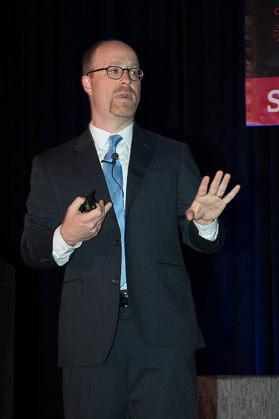 If You Named Me General Counsel Tomorrow…Where Would I Start?
If You Named Me General Counsel Tomorrow…Where Would I Start?
Executive takeaways:
- The best way to deal with lawyers is to think like one
- You should continually review your contracts, disclosure forms and dispute processes
Scott Paler of DeWitt Ross & Stevens S.C said the most important goal for a smart General Counsel in the screening industry is not eliminating all risk; it’s helping to balance the legal risks with business/operational needs, priorities and sales. His approach is that if you can’t afford in-house counsel you should do your best to educate yourself like one. For example, make sure that your client contract is up to date and continue to shoot holes in it. Meanwhile, don’t forget to roll out important contract changes to your existing client base. The same goes for your disclosure forms: you should continuously update your forms with the latest compliance requirements and revisit them 4-5 times every year.
Paler also emphasized the importance of having a rock-solid dispute resolution process. He said disputes are the last stop before a lawsuit and you must have strong practices in place. Moreover, he said you must communicate these practices and have your best people manage those processes.
His other recommendations included:
- Increase identifiers (such as middle name) to decrease risk
- Performing your own internal audits to be proactive
- Know exactly what your insurance does – and does not – cover (i.e., 613 processes may not be included)
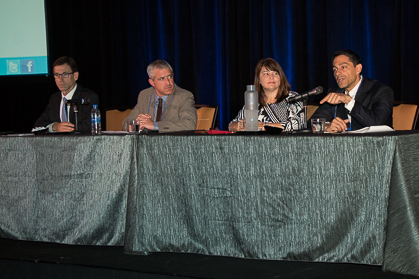 I’ve Been Sued! Now What? How to Improve Your Chances of Success and Keep Costs Under Control
I’ve Been Sued! Now What? How to Improve Your Chances of Success and Keep Costs Under Control
Executive takeaways:
- The lifecycle of a lawsuit can take years
- Though it will be expensive, you can take actions now that will reduce the costs later
It’s not easy to remain calm when you’re served with a lawsuit, but that was the advice from this panel discussion with Henry Chalmers, Arnall Golden Gregory LLP; John Papianou, Montgomery McCracken Walker & Rhoads LLP; Stephanie Morgan, backgroundchecks.com; and Matt O’Connor, First Advantage Background Services Corp. They focused on what you can expect once you’re sued, the steps your company will need to take to successfully defend itself, and strategies for working with your outside counsel to maximize your chances of success.
Their collective advice is to get your attorney involved:
- During a threat
- When you are served
- When you receive a government inquiry
- When you receive an indemnification demand
They said the discovery period lasts 4 to 8 months and the lifecycle of a lawsuit could take several years. The panel said it’s imperative that you preserve all communications and documents – especially emails, phone conversations, logs, documentations of your best practices as well as your contract with your client. The speakers noted that very rarely do FCRA cases make it to trial; most settle before getting that far. If you do go to trial, though, getting started attorney fees can exceed $100K.
Responding to Consumer Inquires
Executive takeaways:
- This is one of the most detailed steps in the FCRA – every step is outlined
- SSN may be a key factor in dispute resolution
This advanced session featured Larry Henry with Rhodes Hieronymus and dealt with the FCRA and state requirements regarding file requests and disputes.
He started by saying that when you’re dealing one-on-one with consumers, there are infinite ways to say or do the wrong thing – and then get sued. He emphasized that consumer inquiries are one of the most detailed processes in the FCRA. Every step is outlined and you need to learn the steps and follow them. Henry said that in today’s security-conscious world, many times a CRA will automatically redact the SSN on the report. Henry said you need to keep in mind that when the consumer (applicant) requests a copy of the report, you cannot redact the SSN unless the consumer requests it. The SSN may be incorrect and redacting the SSN may hinder the consumer in identifying an issue with the report.
Henry’s other recommendations:
- Keep an audit trail of how the status and events changed during the dispute process
- Stay on top of special consumer right notices by jurisdiction (i.e., CA, NJ, VT, WA)
- Disclose the dispute information in writing by mail unless the consumer requests another form of communication
Henry stressed that your people must be thoroughly trained for this process. Find internal staff with the right skills and personality and make sure your process does not create roadblocks for the consumer. His “word to the wise”: be prompt and be complete.
What Staffing Companies Want (and Don’t Realize They Need Yet) in Screening
Executive takeaways: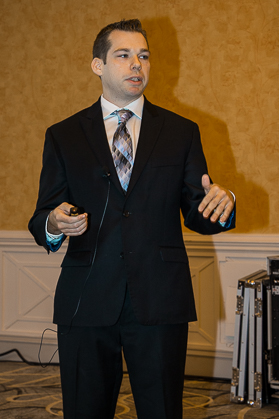
- It’s imperative to establish roles and responsibilities when working with staffing agencies
- It will be necessary to have special arrangements to share contracts or reports
As you’ve probably already discovered, there are unique and complicated compliance issues in employment screening when your customers are staffing agencies or have other third-party employment relationships. Led by Jennifer Mora, Seyfarth Shaw LLP; and William Simmons, Littler Mendelson PC, this session examined what solutions staffing companies want, what solutions they might not realize they need yet, and how a CRA can best meet those and add value without unduly undermining compliance.
The speakers described some hypothetical situations and put forth some special questions that staffing agencies might pose for CRAs:
- What if the CRA adjudicates the no-felony rule for the staffing company?
- Who is responsible for pre-adverse action notices?
- What does the pre-adverse action notice say?
- Do you have a requirement for background checks or to clear background checks?
- When was the last time you reviewed your default background requirements?
Mora and Simmons offered some solutions you might provide:
- Go beyond indemnification, make your client look good
- Maintain documentation that specifies your default search criteria position
- Add permissible purpose for temporary contract sharing
- Make sure the company name on disclosure and authorization is broad enough
- Consider separate document authorization for sharing purposes
- Make sure pre-adverse language fits the situation
- Tell the staffing agency when you can’t handle local pre-adverse notices
Other recommended best practices included acknowledging and embracing clients’ special needs, adding value with education, providing annual percentages of adverse action notices and getting included on the arbitration agreement.
 5 Essential Tactics to Grow Your CRA
5 Essential Tactics to Grow Your CRA
Executive takeaways:
- You need to take a self-inventory
- You must not only make and execute plans but revise them to fit progress
Bruce Berg, owner of Berg Consulting Group, offered keys for self-evaluating current business performance, business growth drivers, and best practice recommendations.
Your Desire – We all have motivators like additional profits, increased value, ego, etc. We also have de-motivators such as stress, exposure, investment, space, etc.
Your Ability – How strong is your Sales team? How strong is your technology? Do you have enough cash on hand. Can you manage people (and not just things)?
Your Plan – How do you take your abilities and put them into something actionable?
Your Execution – Can you prioritize your work? Measure results? This is where most people fail.
Review – You must “measure to manage” and act on the results. You should create an annual plan as well as 1-3-5 year plans and revise them as needed to fit your progress.
 Retention, Retention, Retention: 5 Keys to Winning & Retaining Customers
Retention, Retention, Retention: 5 Keys to Winning & Retaining Customers
Executive takeaways:
- Companies should begin to think long-term and build channels that match how millennials already communicate
- Involve your entire team in communication efforts
Bryan Snow with Wholesale Screening Solutions opened with some interesting statistics:
- It is 6X more expensive to attract a new customer than it is to retain an existing one
- 39% of customers avoid a vendor for 24 months after having a negative experience
- 85% warn others about doing business with that company
- By 2020, customer experience could overtake product/price as a key differentiator
He listed “5 Key Ways to Win and Retain More Business”
- Ask the right questions…and then listen
- Set & manage detailed expectations
- Communicate – develop a set of (no more than) 5 core questions and then be curious
- Be prepared – knowledge is power; you should be the subject matter expert
- Be genuine – tell the truth and be transparent
Snow said for things to work seamlessly, you must involve your whole team in communications. Face-to-face meetings are best. You must also arm your team and clients with the technologies needed to succeed. For example, using CHAT systems decrease response time to clients and increase customer service efficiency.
He noted the “7Ps” of preparedness: Prior proper planning prevents piss-poor performance.
 GDPR: Steps to Meet Key Requirements
GDPR: Steps to Meet Key Requirements
Executive takeaways:
- The requirements for screening in the EU are changing dramatically
- CRAs should get a head-start on meeting the new requirements before they go into effect next year.
General Data Protection Regulation (GDPR) goes into effect on May 25, 2018 in the EU. The regulations are extensive, as Kerstin Bagus with ClearStar Inc. dramatically demonstrated when she rolled out a printed copy for the session attendees. She and Kevin Coy with Arnall Golden Gregory covered the main requirements that CRAs will need to address in order to meet the new rules.
Coverage includes:
- Screeners inside the EU
- Screeners outside the EU doing work for EU-based customers
- Screeners outside the EU doing work for customers based outside the EU involving EU-based applicants/employees
- Screeners outside the EU doing work for customers based outside the EU involving an applicant that once lived or worked in the EU
The speakers emphasized that now is the time for each CRA to designate someone who will own the GDPR project and champion the process. That person needs to read the entire GDPR in detail.
The project champion will need to understand:
- Process/controller rules
- Requirements for small and medium businesses
- Processing for special categories
- Transferring data out of EU
- What is being processed and collection limitations
The speakers stressed that CRAs should be focusing now on re-contracting all clients and vendors to meet these upcoming requirements. They also cautioned that the GDPR is new and interpretation of the regulation will evolve.
 Legalized Marijuana – The Untold Reality
Legalized Marijuana – The Untold Reality
Executive takeaways:
- Public support of legalizing marijuana, has grown exponentially since the 60’s
- The cost of marijuana-related litigation to employers could be in the trillions of dollars
Nina French of The Current Consulting Group took a look at the current state of marijuana legalization laws and its cost to employers. Legalized marijuana is likely to cost U.S. employers an estimated $180 billion each year in increased absenteeism, workers’ compensation claims, lost productivity and increased health care coverage costs, not to mention another $26.4 trillion in potential litigation costs.
French noted that a marijuana-related employment case that is settled out of court costs an average of $125,000. Insurance usually covers $35,000 and the employer is left to pay $90,000 out of pocket. If a court case goes all the way to judgment, the average cost is $200,000, leaving the employer to pay $165,000 after insurance. About 25% of the cases that go to court result in judgment costs of $500,000, meaning the employer must pay $465,000.
Colorado has more marijuana dispensaries than Starbucks and McDonald’s locations combined. States with legalized use have seen significant rises in fatal DUID crashes, ER visits and related hospitalizations. Still, in a 2015 Gallup poll, 58% of Americans supported legalization.
Doctors are not actually able to “prescribe” marijuana; they can only recommend it. An interesting fact French revealed is that according to a 2016 study, 45% of medical marijuana dispensary staff have received no formal training and routinely recommend incorrect THC dosage amounts to patients in need.
French’s advice for screeners is to continue to support testing, conduct annual policy reviews, encourage advocacy with employers and take a consultative approach with clients.
Drug & Alcohol Testing Compliance Minefield: Your Roadmap to Success
Executive takeaways:
- You can’t just go out and start a drug screening business; policies are more important than you’d think
- Drug Screen providers need to ensure that their clients are staying within the legal bounds of state laws
Bill Judge of Encompass Compliance started this session with a brief overview of the industry.
- Drug/alcohol testing has been taking place for about 40 years
- Approximately 45 million tests are done each year
- 600+ state laws & 12,000+ court rulings impact workplace testing
- Management of those programs becomes increasingly complicated each year.
He showed that employers are stuck in the middle of competing and conflicting rules and regulations at the federal, state, and even city levels. Rulings and fines for non-compliance range between $30,000-$1.8 million.
Judge said most states require a written policy before even beginning the process to fight workers’ comp cases. More important than the process itself, crafting policies require making an outline of who, what, when, where and why. You can’t just use a DOT policy and apply it. Policies vary on what you want to do and which rules apply.
If you’re an NAPBS member, you can access many of the slide decks from the conference at:
https://www.napbs.com/resources/conference-presentations/
NAPBS will hold its 2017 Mid-Year Legislative & Regulatory Conference April 15-17, 2018
